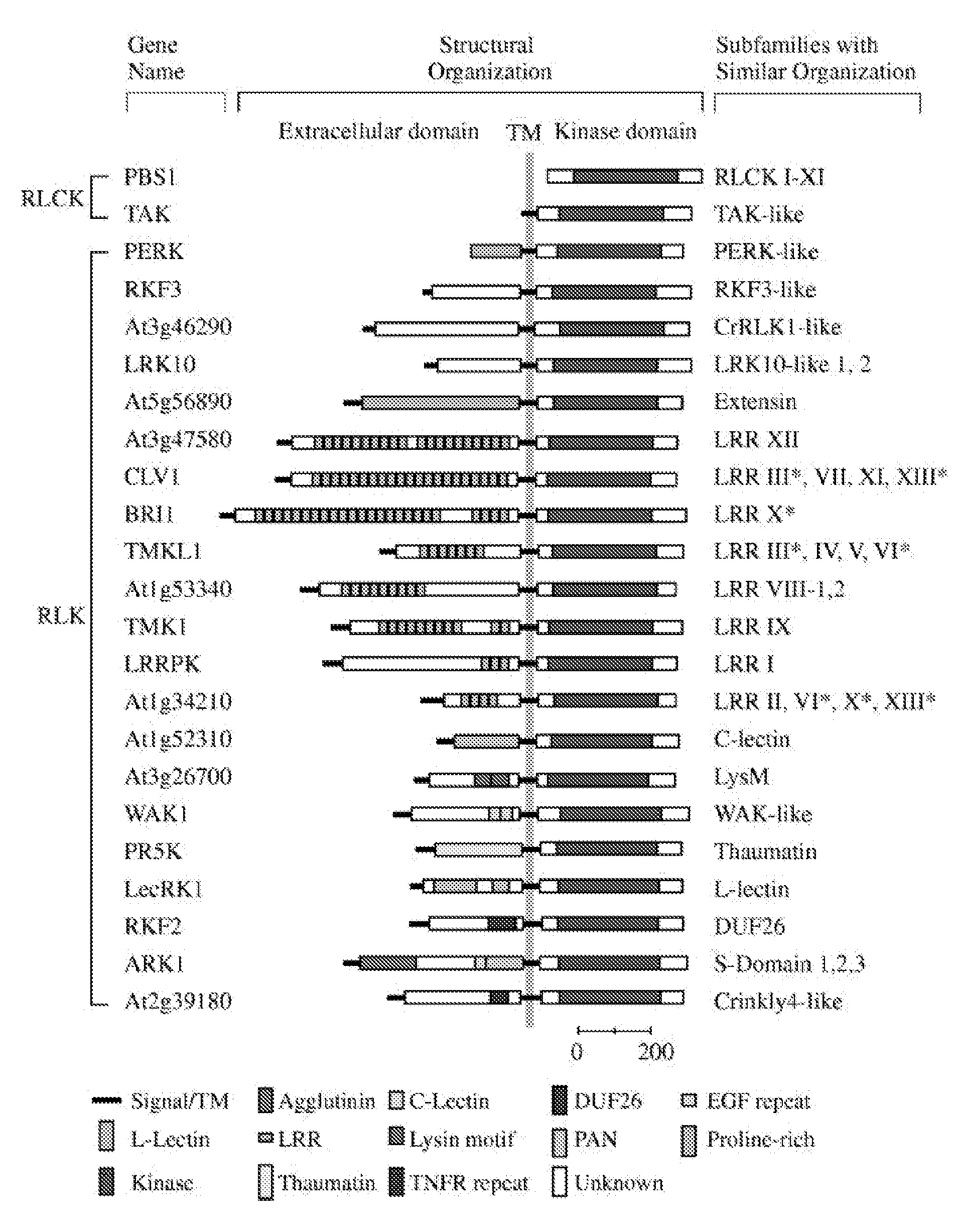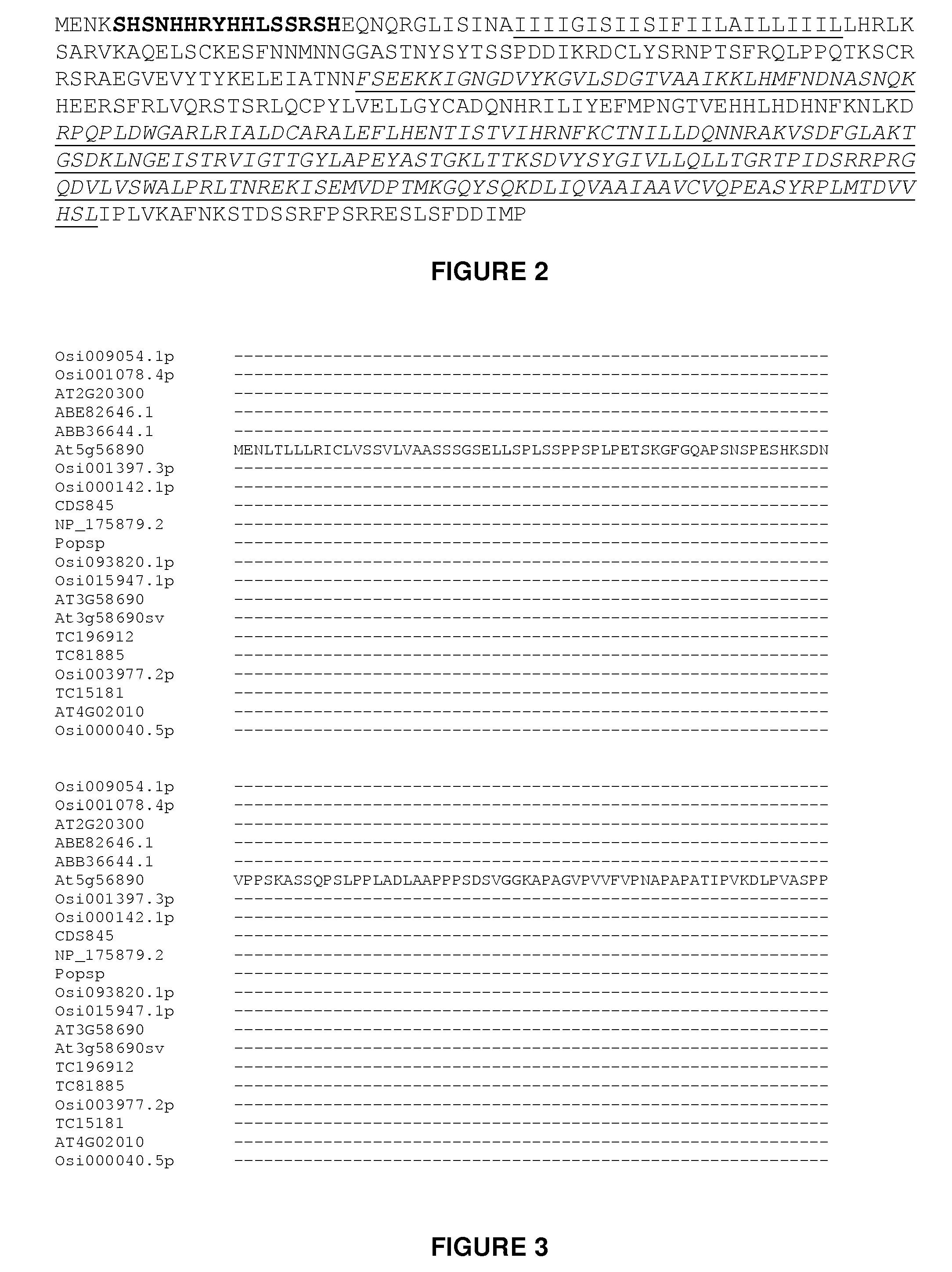Plants having enhanced yield-related traits and a method for making the same
a technology of yield-related traits and plants, which is applied in the field of plants having enhanced yield-related traits and a method for making the same, can solve the problems of transgenic plants with reduced fertility, poor early vigor, and no phenotypic information to date on cle2 mutants
- Summary
- Abstract
- Description
- Claims
- Application Information
AI Technical Summary
Benefits of technology
Problems solved by technology
Method used
Image
Examples
example 1
Identification of Homologues of the ERLK Protein of SEQ ID NO: 2 in Arabidopsis, Rice and Other Plant Species
[0761]Sequences (full length cDNA, ESTs or genomic) related to the nucleic acid sequence used in the methods of the present invention were identified amongst those maintained in the Entrez Nucleotides database at the National Center for Biotechnology Information using database sequence search tools, such as the Basic Local Alignment Tool (BLAST) (Altschul et al. (1990) J. Mol. Biol. 215:403-410; and Altschul et al. (1997) Nucleic Acids Res. 25:3389-3402). This program is typically used to find regions of local similarity between sequences by comparing nucleic acid or polypeptide sequences to sequence databases and by calculating the statistical significance of matches. The polypeptide encoded by the nucleic acid of the present invention was used with the TBLASTN algorithm, with default settings and the filter for ignoring low complexity sequences was set off. The output of th...
example 2
Determination of Global Similarity and Identity Between the Kinase Domains of ERLK Proteins
[0763]Percentages of similarity and identity between the kinase domains of ERLK proteins were determined using MatGAT (Matrix Global Alignment Tool) software (BMC Bioinformatics. 2003 4:29. MatGAT: an application that generates similarity / identity matrices using protein or DNA sequences. Campanella J J, Bitincka L, Smalley J; software hosted by Ledion Bitincka). MatGAT software generates similarity / identity matrices for DNA or protein sequences without needing pre-alignment of the data. The program performs a series of pair-wise alignments using the Myers and Miller global alignment algorithm (with a gap opening penalty of 12, and a gap extension penalty of 2), calculates similarity and identity using for example Blosum 62 (for polypeptides), and then places the results in a distance matrix. Sequence similarity is shown in the bottom half of the dividing line and sequence identity is shown in ...
example 3
Cloning of the Nucleic Acid Sequence Used in the Methods of the Invention
[0765]DNA manipulation: unless otherwise stated, recombinant DNA techniques are performed according to standard protocols described in (Sambrook (2001) Molecular Cloning: a laboratory manual, 3rd Edition Cold Spring Harbor Laboratory Press, CSH, New York) or in Volumes 1 and 2 of Ausubel et al. (1994), Current Protocols in Molecular Biology, Current Protocols. Standard materials and methods for plant molecular work are described in Plant Molecular Biology Labfax (1993) by R. D. D. Croy, published by BIOS Scientific Publications Ltd (UK) and Blackwell Scientific Publications (UK).
[0766]The nucleic acid sequence used in the methods of the invention was amplified by PCR using as template a custom-made Arabidopsis thaliana seedlings cDNA library (in pCMV Sport 6.0; Invitrogen, Paisley, UK). PCR was performed using Hifi Taq DNA polymerase in standard conditions, using 200 ng of template in a 50 μl PCR mix. The prime...
PUM
| Property | Measurement | Unit |
|---|---|---|
| Tm | aaaaa | aaaaa |
| temperature | aaaaa | aaaaa |
| temperature | aaaaa | aaaaa |
Abstract
Description
Claims
Application Information
 Login to View More
Login to View More - R&D
- Intellectual Property
- Life Sciences
- Materials
- Tech Scout
- Unparalleled Data Quality
- Higher Quality Content
- 60% Fewer Hallucinations
Browse by: Latest US Patents, China's latest patents, Technical Efficacy Thesaurus, Application Domain, Technology Topic, Popular Technical Reports.
© 2025 PatSnap. All rights reserved.Legal|Privacy policy|Modern Slavery Act Transparency Statement|Sitemap|About US| Contact US: help@patsnap.com



